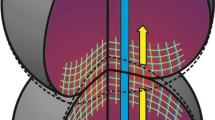Abstract
We study the time evolution of non-linear viscoelastic solids in the presence of inertia and (self-)contact. For this problem we prove the existence of weak solutions for arbitrary times and initial data, thereby solving an open problem in the field. Our construction directly includes the physically correct, measure-valued contact forces and thus obeys conservation of momentum and an energy balance. In particular, we prove an independently useful compactness result for contact forces.
Similar content being viewed by others
Notes
In the absence of rigid bodies and point-masses this turns out to also be a sufficient assumption. For more details see the discussion in Sect. 6.
As a necessary step towards the proof, we also improve their result to give a quantization of the contact force as a measure, which in [13] was only characterized as part of a distribution. We thus in fact solve both of their open problems (See Remark 5.1). In particular, we believe that the more detailed treatment of convergence of contact forces used for this might be of independent interest.
To reduce the distinction between cases, it is best to not think of \(\Omega \) as the domain, but of \(\mathbb {R}^n \setminus \Omega \) as a fixed, rigid obstacle. Thus \(n_\Omega \) is the interior normal of that obstacle, in the same way \(n_\eta \) is the interior normal of the movable solids.
Note that this implies that (3.5) characterizes the interior of \(T_{\eta }(\mathcal {E})\). Additionally, for a sufficiently regular \(\eta \), it is not hard to prove that (iv) is in fact equivalent to the other three conditions. However, this proof involves splitting \(\varphi \) into its precise normal and tangential components and is thus not easily transferred to the general situation.
As before, \(\eta ^{-1}\) denotes the preimage of \(\eta (t,\cdot )\).
To avoid confusion, we note that since we use interior normals, some signs and inequalities have to be turned around.
References
Ambrosio, L., Fusco, N., Pallara, D.: Functions of Bounded Variation and Free Discontinuity Problems. The Clarendon Press, Oxford University Press, New York, Oxford Mathematical Monographs (2000)
Antman, S.S.: Physically unacceptable viscous stresses. Z. Angew. Math. Phys. 49, 980–988 (1998)
Benešová, B., Kampschulte, M., Schwarzacher, S.: A variational approach to hyperbolic evolutions and fluid-structure interactions. J. Eur. Math. Soc. (online first) (2023)
Benešová, B., Kampschulte, M., Schwarzacher, S.: Variational methods for fluid—structure interaction and porous media. Nonlinear Anal. Real World Appl. 71, 103819 (2023)
Ciarlet, P.G., Nečas, J.: Injectivity and self-contact in nonlinear elasticity. Arch. Ration. Mech. Anal. 97, 171–188 (1987)
Clarke, F.H.: Optimization and Nonsmooth Analysis. Society for Industrial and Applied Mathematics (1990)
Dal Maso, G., Larsen, C.J.: Existence for wave equations on domains with arbitrary growing cracks. Atti. Accad. Naz. Lincei Rend. Lincei Mat. Appl. 22, 387–408 (2011)
De Giorgi, E.: New problems on minimizing movements. In: Boundary Value Problems for Partial Differential Equations and Applications, Vol. 29 of RMA Res. Notes Appl. Math., Masson, Paris, pp. 81–98 (1993)
Gravina, G., Schwarzacher, S., Souček, O., Tůma, K.: Contactless rebound of elastic bodies in a viscous incompressible fluid. J. Fluid Mech. 942, A34 (2022)
Healey, T.J., Krömer, S.: Injective weak solutions in second-gradient nonlinear elasticity. ESAIM Control Optim. Calc. Var. 15, 863–871 (2009)
Hillairet, M.: Lack of collision between solid bodies in a 2d incompressible viscous flow. Commun. Part. Differ. Equ. 32, 1345–1371 (2007)
Hytönen, T., van Neerven, J., Veraar, M., Weis, L.: Analysis in Banach Spaces: Volume I: Martingales and Littlewood–Paley Theory, Ergebnisse der Mathematik und ihrer Grenzgebiete, vol. 3. Folge, Springer Science (2016)
Krömer, S., Roubíček, T.: Quasistatic viscoelasticity with self-contact at large strains. J. Elast. 142, 433–445 (2020)
Neff, P.: On Korn’s first inequality with non-constant coefficients. Proc. R. Soc. Edinb. Sect. A 132, 221–243 (2002)
Palmer, A., Healey, T.: Injectivity and self-contact in second-gradient nonlinear elasticity. Calc. Variat. Part. Differ. Equ. 56, (4):114. https://doi.org/10.1007/s00526-017-1212-y (2017)
Palmer, A.Z.: Variations of deformations with self-contact on Lipschitz domains. Set-Valued Var. Anal. 27, 807–818 (2019)
Pompe, W.: Korn’s first inequality with variable coefficients and its generalization. Comment. Math. Univ. Carolin. 44, 57–70 (2003)
Schuricht, F.: Variational approach to contact problems in nonlinear elasticity. Calc. Var. Part. Differ. Equ. 15, 433–449 (2002)
Acknowledgements
The authors acknowledge the support of the the Primus research programme of Charles University under Grant No. PRIMUS/19/SCI/01. The research of A.Č. and M.K. was partly funded by the ERC-CZ Grant LL2105. A.Č. further acknowledges the support of Charles University, project GA UK No. 393421. The work of G.G. and M.K. was partially supported by the Charles University research program No. UNCE/SCI/023 and by the Czech Science Foundation (GAČR) under Grant No. GJ19-11707Y.
Author information
Authors and Affiliations
Corresponding author
Additional information
Communicated by Andrea Mondino.
Publisher's Note
Springer Nature remains neutral with regard to jurisdictional claims in published maps and institutional affiliations.
Rights and permissions
Springer Nature or its licensor (e.g. a society or other partner) holds exclusive rights to this article under a publishing agreement with the author(s) or other rightsholder(s); author self-archiving of the accepted manuscript version of this article is solely governed by the terms of such publishing agreement and applicable law.
About this article
Cite this article
Češík, A., Gravina, G. & Kampschulte, M. Inertial evolution of non-linear viscoelastic solids in the face of (self-)collision. Calc. Var. 63, 55 (2024). https://doi.org/10.1007/s00526-023-02648-7
Received:
Accepted:
Published:
DOI: https://doi.org/10.1007/s00526-023-02648-7




